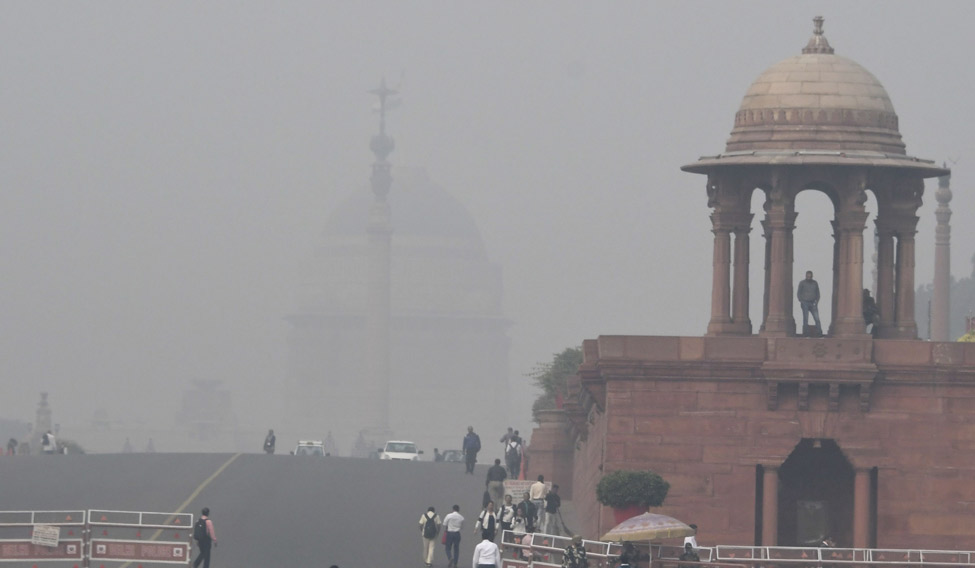There’s a nip in the air in the Indian capital, as winter sets in. However, the sun, which usually offers soothing November warmth, has turned pale orange, shrouded in an ungodly mist.
As he steps out of the crowded Delhi’s Hazrat Nizamuddin railway station, Mumbai-based trader Mohit Shringi’s eyes begin to burn. An uneasy itch crawls down his throat. He takes a deep breath, hoping to ease the discomfort. What flows in is a toxic mix of gases, which in a few minutes will render him bedridden for the day.
“By the time I got to my hotel, my eyes were watering. I felt unwell and threw up,” he recounts.
Mohit’s is not an isolated experience. Over the past few weeks, Delhi’s deteriorating air quality has led to a marked increase in the number of people seeking treatment for respiratory ailments. The Indian Medical Association describes the situation as a "public health emergency." Schools have been closed and people have been advised to avoid outdoor activities.
The alarm is a product of rising levels of PM2.5, i.e. airborne particulate matter 30 times finer than human hair that can enter the respiratory tract and lodge deep inside people’s lungs. While the WHO recommendation for PM2.5 concentration is 25 micrograms per cubic meter, an upper limit of 50 is still considered a good level. In India’s national capital region over the past few weeks, however, the level has consistently hovered above 400, even breaching the 1000 mark on occasion.
Serious health hazards
In the short term, this can result in increased respiratory infections, allergies and asthma, while long-term exposure to high levels of PM2.5 can potentially cause heart diseases, strokes, lung cancer, premature deaths and impair cognitive development.
What’s more, new research has made it amply clear that the threat from air pollution is not a future concern. It is a clear and present danger.
For instance, a study in the Journal of Indian Pediatrics has found that children growing up in Delhi’s polluted environment experience reduced lung growth compared to those in the US. This results in reduced exercise capacity and greater vulnerability to respiratory illnesses.
Likewise, a recent Ministry of Health and Family Welfare-led study estimates that outdoor and indoor air pollution accounted for 6.4% and 4.8% of the total disease burden in India in 2016. Meanwhile, a paper published in the medical journal Lancet states that over half a million deaths in India in 2015 could be attributed to PM2.5 air pollution. That accounted for nearly one-fourth of all PM2.5-related deaths across Asia.
A chronic problem
The current smog across much of north India is justifiably being blamed on farmers, particularly those in the states of Punjab, Haryana and Uttar Pradesh, burning crop residue. This is a regular practice this time of the year, which results in alarm, discussion and even political bickering.
However, the underlying message from the above-mentioned studies is that air pollution in India - Delhi in particular, is neither a seasonal phenomenon nor is it a product of merely one factor. In other words, air pollution is not an acute but rather a chronic problem, with a slew of studies pointing at road dust, vehicles, household and industrial pollution along with waste burning as the major culprits.
Identifying the constituents of the noxious mix that we are breathing is a crucial starting point in working towards a cleaner future. However, in doing so, it is also important to acknowledge that the pollution crisis that India’s capital is facing is a result of near-sighted, ineffective and poorly executed public policies.
For instance, the Delhi government has sought to impose vehicular restrictions, such as the odd-even rule, as a knee-jerk and emergency measure. However, the experience of other megalopolises, such as Mexico City and Beijing, shows that vehicular restrictions of different types can be effective only if accompanied by improvement in public transport. This means long-term planning and investments, which yield better systems and services.
Likewise, declaring stubble burning as illegal while not offering financial and technological support to farmers to dispose off the waste via alternate means serves little purpose. These are nothing more than temporary fixes.
Conventional wisdom informs us that linkages exist between economic growth and increased environmental pollution. Such a belief indicates that the price of development inherently implies a faustian bargain with the demon of toxicity. However, new information debunks such myths. In fact, there is a growing understanding today that rather than being a price to be paid for development, environmental pollution is actually imposing costs on development. A World Bank study last year found that in 2013, China lost nearly 10% of its GDP and India 7.69% owing to welfare costs, lost work days and premature deaths linked to air pollution.
Clearly, there is enough incentive for policymakers to factor in pollution-related externalities into public policy. What is now needed is sustained public involvement along with vision and political will.
The author is a senior multimedia journalist and Chinese affairs analyst based in New Delhi





